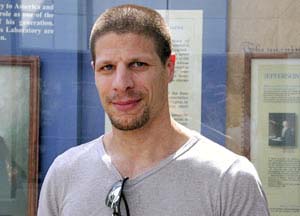
NEWPORT NEWS, VA. - An experiment probing the internal structure of the proton has earned Israeli scientist Guy Ron the 2008 JSA Thesis Prize. The prize is awarded annually for the best Ph.D. dissertation resulting from research performed at the Department of Energy's Thomas Jefferson National Accelerator Facility.
"The proton is not a point particle. It has some structure inside it, particles known as quarks. These quarks are charged and they're moving around in there," Ron said.
The proton contains three quarks, and each quark carries an electric charge and magnetic moment. As they move, the charged quarks produce a magnetic field. The result of quarks moving around inside the proton is a distribution of electric and magnetic fields. "And in that experiment, we measured how these electric and magnetic distributions are different from each other," Ron explained.
The data Ron and his colleagues collected in his thesis experiment prompted the scientists to follow up with a dedicated, more precise measurement of the proton last fall. The result is expected soon. Ron completed his thesis, titled The Proton Elastic Form Factor Ratio at Low Q2, and earned his Ph.D. at Tel Aviv University in Israel. He will present his thesis work at the Users Group Workshop and Annual Meeting at Jefferson Lab on June 8-10.
Ron expressed surprise at having won the prize."In Hebrew, you translate this as the imposter syndrome. You feel like an imposter; people are handing you things you couldn't possibly deserve. And I definitely could not have done any of the work without the people in my collaboration. Everybody else worked really hard on it, and it is as much their award as mine," he said.
Ron Gilman, a professor at Rutgers University and chairperson of the Jefferson Lab Users Group Board, which oversees selection of the winner, said the board was impressed with the quality of nominations for this year's prize. "I was told by various people both in person and in recommendations that several of the Ph.D. students were excellent and absolutely deserved the prize this year. The students did excellent research. What particularly set Guy Ron above the other students was that he proposed, defended, and led the running of a follow-up experiment to his own Ph.D. research, all while still in graduate school."
Hugh Montgomery, Jefferson Science Associates president and Jefferson Lab director, said that award-winning research, such as Guy Ron's, strengthens Jefferson Lab's reputation as a world-leading nuclear physics laboratory and makes it a place where young scientists can launch their careers and have an impact.
“If Jefferson Lab is to fulfill its mission to understand our universe, it is important that we provide opportunities for the next generation of scientists, because it is they who will carry on the research that we do today and, hopefully, make the future discoveries that will benefit all of society.”
Ron, who just began a six-month postdoctoral position at the Weizmann Institute of Science in Israel, will begin a second postdoc at the University of California, Berkeley, in August. In his new research focus, he's using lasers to trap radioactive atoms to study the radiation given off by these atoms. The weak force is responsible for radiation, and Ron's research is in some ways similar to experiments probing the weak force at Jefferson Lab.
"It's a very different technique, but it's the kind of experiment that's very complementary to experiments like Q-weak and others," Ron said.
The Thesis Prize is awarded to a graduate student who has carried out research related to Jefferson Lab science. It is awarded for the best graduate student thesis and includes a stipend of $2,000 and a commemorative plaque. Four areas are considered in rating the submitted theses: the quality of the written dissertation, the student's contribution to the research, the work's impact on the field of physics and service (how the work benefits Jefferson Lab or other experiments).
The Thesis Prize was established in 1999 by the Southeastern Universities Research Association, the predecessor management and operating contractor for Jefferson Lab. It is one of many projects supported by the JSA Initiatives Fund, a program funded by the JSA owners (SURA and CSC/ATD) to support efforts that further the scientific outreach and promote the science, education and technology missions of Jefferson Lab and the Lab’s user community. The annual commitment of $0.5 Million is administered by the JSA Programs Committee. For more information about the program, see http://www.jsallc.org/IF/IFIndex.html.
Contact: Dean Golembeski, Jefferson Lab Public Affairs, 757-269-7689, deang@jlab.org

